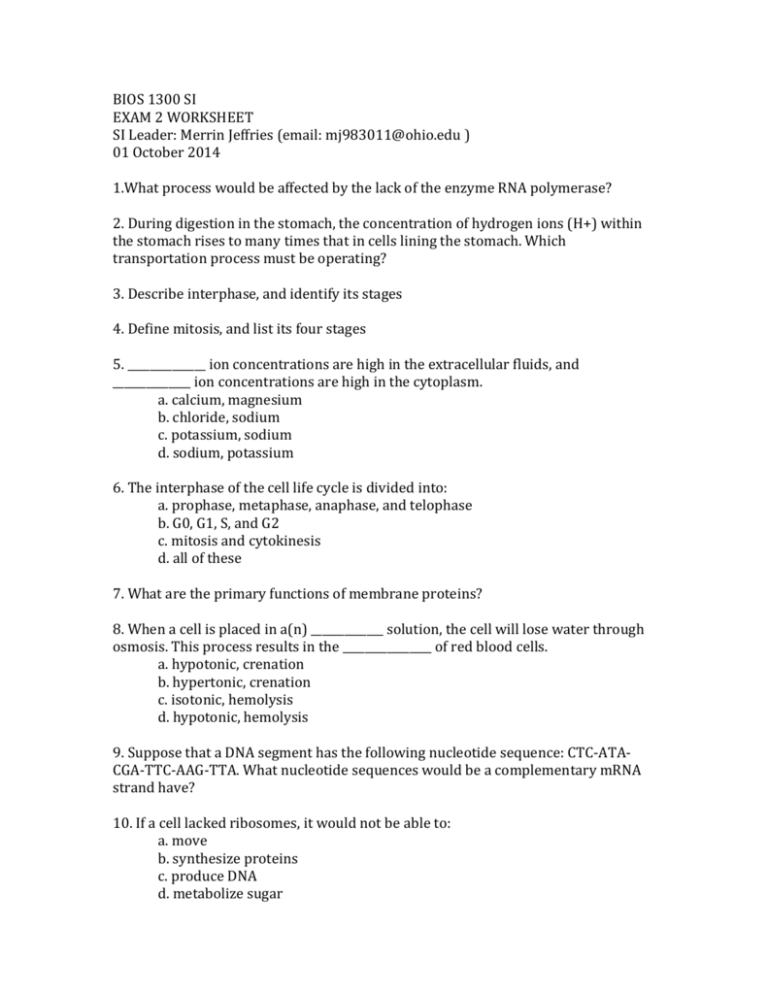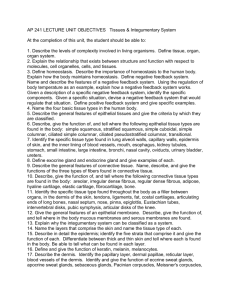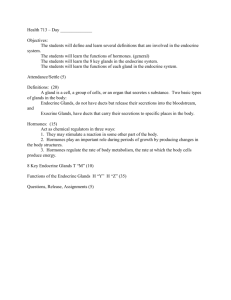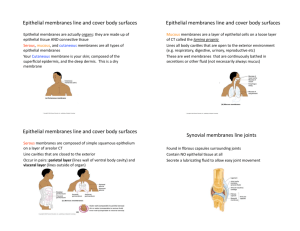BIOS 1300 SI EXAM 2 WORKSHEET SI Leader: Merrin Jeffries
advertisement

BIOS 1300 SI EXAM 2 WORKSHEET SI Leader: Merrin Jeffries (email: mj983011@ohio.edu ) 01 October 2014 1.What process would be affected by the lack of the enzyme RNA polymerase? 2. During digestion in the stomach, the concentration of hydrogen ions (H+) within the stomach rises to many times that in cells lining the stomach. Which transportation process must be operating? 3. Describe interphase, and identify its stages 4. Define mitosis, and list its four stages 5. ______________ ion concentrations are high in the extracellular fluids, and ______________ ion concentrations are high in the cytoplasm. a. calcium, magnesium b. chloride, sodium c. potassium, sodium d. sodium, potassium 6. The interphase of the cell life cycle is divided into: a. prophase, metaphase, anaphase, and telophase b. G0, G1, S, and G2 c. mitosis and cytokinesis d. all of these 7. What are the primary functions of membrane proteins? 8. When a cell is placed in a(n) _____________ solution, the cell will lose water through osmosis. This process results in the ________________ of red blood cells. a. hypotonic, crenation b. hypertonic, crenation c. isotonic, hemolysis d. hypotonic, hemolysis 9. Suppose that a DNA segment has the following nucleotide sequence: CTC-ATACGA-TTC-AAG-TTA. What nucleotide sequences would be a complementary mRNA strand have? 10. If a cell lacked ribosomes, it would not be able to: a. move b. synthesize proteins c. produce DNA d. metabolize sugar e. divide 11. (a) what is cytokinesis? (b) what is the role of cytokinesis on the cell cycle? 12. Identify the various types of epithelial intercellular connections 13. What is the functional significance of gap junctions? 14. Name the 2 primary types of glandular epithelia 15. The secretory cells of sebaceous glands fill with secretions and then rupture, releasing their contents. Which mode of secretion is this? 16. A gland has no ducts to carry the glandular secretions, and the gland’s secretions are released directly into the extracellular fluid. Which type of gland is this? 17. Differentiate between endocrine and exocrine glands. 18. By what 3 methods do various glandular epithelial cells release their secretions? 19. What is the difference between exocrine secretion and endocrine secretion? 20. Assuming that you had the necessary materials to perform a detailed chemical analysis of body secretions, how could you determine whether a secretion was merocrine or apocrine? 21. A type of junction common in cardiac and smooth muscle tissue is the: a. hemidesmosome b. basal junction c. occluding junction d. gap junction 22. The most abundant connections between cells in the superficial layers of the skin are: a. connexons b. gap junctions c. macula adherens d. occluding junctions 23. Mucous secretions that coat the passageways of the digestive and respiratory tracts result from ________________ secretion. a. apocrine b. merocrine c. holocrine d. endocrine 24. The primary function of serous membranes in the body is to: a. minimize friction between opposing surfaces b. line cavities that communicate with the exterior c. perform absorptive and secretory functions d. cover the surface of the body 25. The type of cartilage growth characterized by adding new layers of cartilage to the surface is: a. interstitial b. appositional c. intramembranous d. longitudinal 26. Dandruff is caused by excessive shedding of cells from the outer layer of skin in the scalp. Thus, dandruff is composed of cells from which epidermal layer? 27. Why does swimming in fresh water for an extended period cause epidermal swelling? 28. Why does exposure to sunlight darken skin? 29. Why does the skin of a fair-skinned person appear red during exercise in hot weather? 30. Identify 2 types of exocrine glands found in the skin 31. What are the functions of sebaceous secretions? 32. Deodorants are used to mask the effects of secretions from which type of skin gland? 33. Which type of skin gland is most affected by the hormonal changes that occur during puberty? 34. Why can skin regenerate effectively even after considerable damage? 35. List the 4 stages in the regeneration of the skin after an injury. 36. How do insensible perspiration and sensible perspiration differ? 37. In clinical practice, drugs can be delivered by diffusion across the skin; this delivery method is called transdermal administration. Why are fat-soluble drugs more suitable for transdermal administration than drugs that are water soluble? 38. The 2 types of exocrine glands in the skin are: a. merocrine and sweat glands b. sebaceous and sweat glands c. apocrine and sweat glands d. eccrine and sweat glands 39. Apocrine sweat glands can be controlled by: a. the autonomic nervous system b. regional control mechanisms c. the endocrine system d. both a and c 40. The primary function of sensible perspiration is to: a. get rid of wastes b. protect the skin from dryness c. maintain electrolyte balance d. reduce body temperature 41. The darker an individual’s skin color, a. the more melanocytes she has in her skin b. the more layers she has in her epidermis c. the more melanin her melanocytes produce d. the more superficial her blood vessels are 42. In the elderly, blood supply to the dermis is reduced and sweat glands are less active. The combination of factors would most affect: a. the ability to thermoregulate b. the ability to heal injured skin c. the ease with which the skin is injured d. the physical characteristics of the skin e. the ability to grow hair 43. Mature bone cells are known as ________________, bone-building cells are called ________________, and _________________ are bone-resorbing cells. 44. Compare the structures and functions of compact bone and spongy bone. 45. A sample of bone has lamellae, which are not arranged in osteons. Is the sample most likely taken from epiphysis or diaphysis? 46. In endochondral ossification, what is the original source of osteoblasts? 47. During intramembranous ossification, which type(s) of tissues is (are) replaced by bone? 48. List the 4 distinctive cell populations of osseous tissue. 49. What are the primary parts of a typical long bone? 50. If spongy bone has no osteons, how do nutrients reach the osteocytes?








